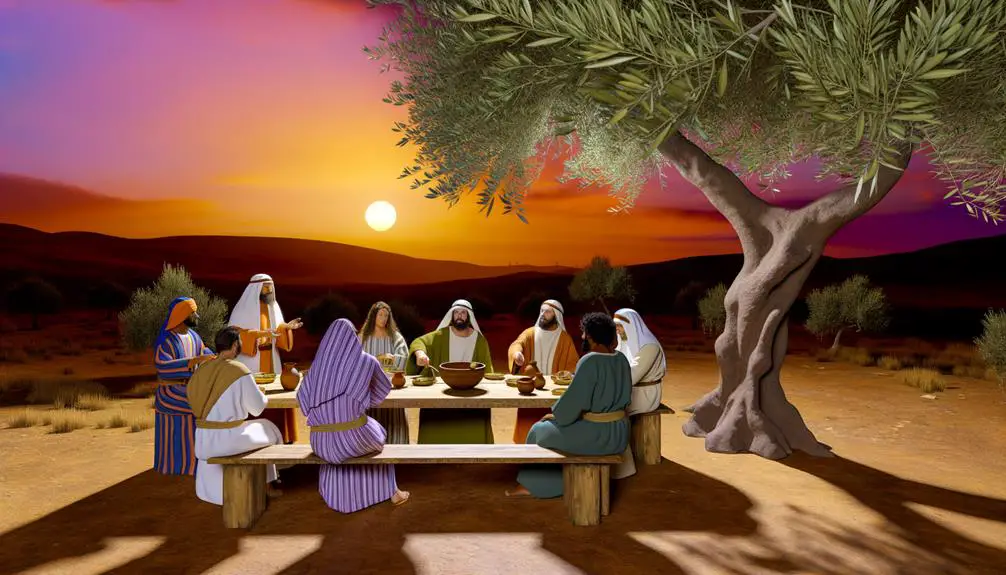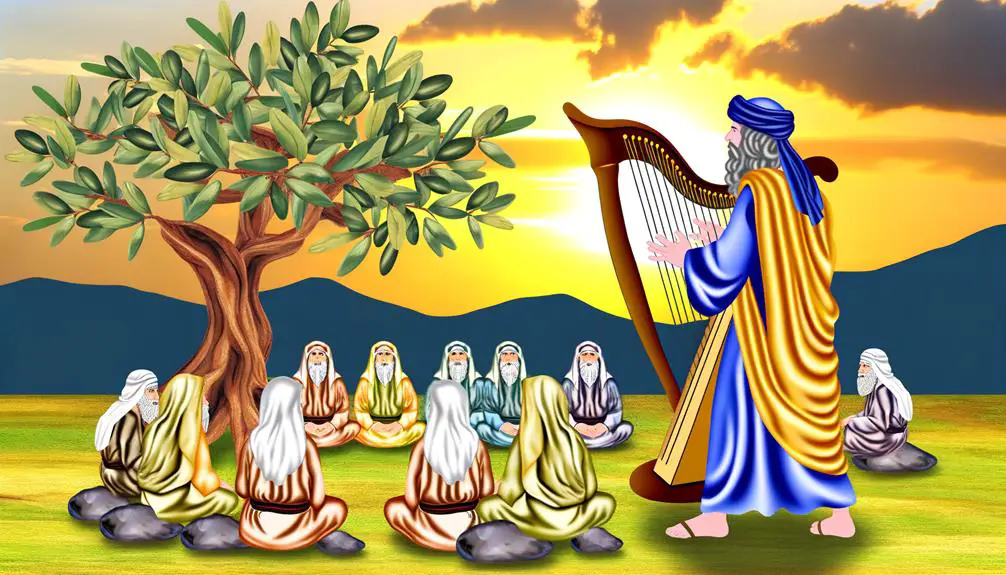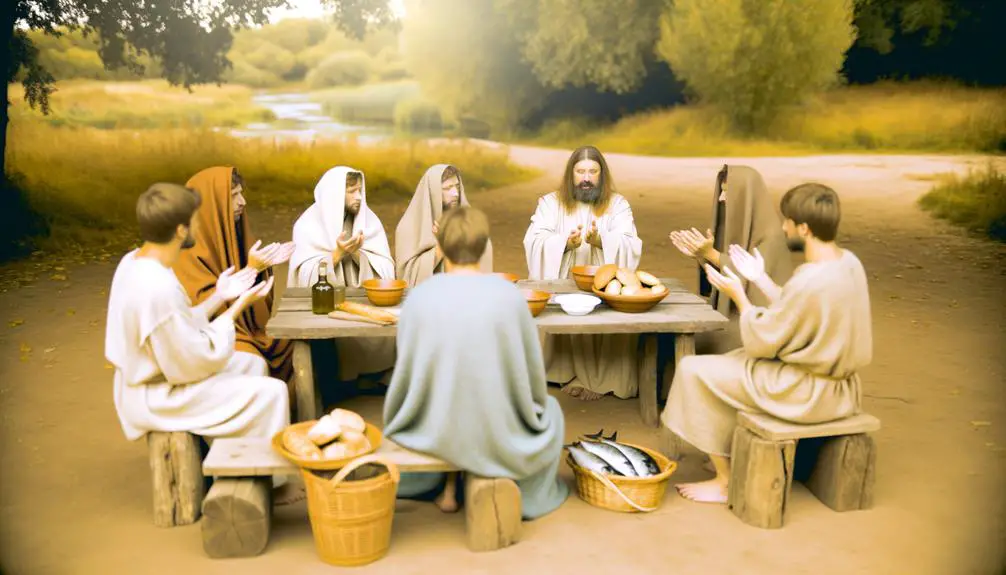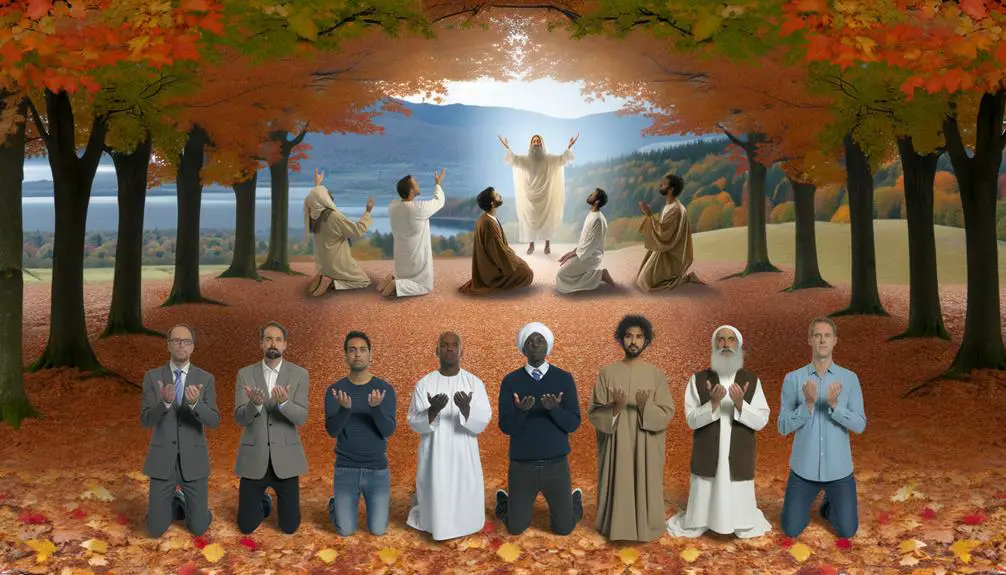From David's songs to Paul's letters, explore the rich tapestry of Thanksgiving in the Bible and discover its profound implications.

Examples of Thanksgiving in the Bible
In the Bible, you'll encounter multiple instances of Thanksgiving that reflect diverse expressions of gratitude. For instance, in 1 Chronicles 16, David's Song of Thanks includes profound humility and divine sovereignty, emphasizing worship through song and instruments. Similarly, Levitical Thanksgiving offerings, detailed in Leviticus 7:12-15, highlight a structured protocol with symbolic elements like unleavened bread, illustrating communal unity. Moreover, in the New Testament, Jesus frequently expresses thanks for food, underscoring the importance of recognizing God's provision. Paul's epistles also weave thankfulness into their fabric, fostering spiritual encouragement and community bonds. Further exploration will reveal deeper insights into these practices.
Key Takeaways
- David's Song of Thanks in 1 Chronicles 16 features profound expressions of gratitude and praise to God through song and music.
- The Levitical Thanksgiving Offerings, as described in Leviticus 7:12-15, involve a structured protocol with offerings like unleavened bread to express gratitude.
- Jesus demonstrates thanksgiving for food, emphasizing the importance of acknowledging God's provision in daily life.
- In Paul's Letters, gratitude is a recurring theme, strengthening communal bonds and acknowledging God's grace in relationships and ministry.
- The story of the Ten Lepers, where only one returns to thank Jesus, illustrates the importance of gratitude and recognition of divine blessings.
David's Song of Thanks

David's Song of Thanks, found in 1 Chronicles 16, encapsulates his profound gratitude to God, showcasing a rich tapestry of praise and acknowledgment of divine sovereignty. This passage not only exemplifies David's humility but also intricately weaves worship elements throughout, offering you a multifaceted perspective on biblical thanksgiving.
You'll notice that David's humility is central to his thanksgiving. He attributes all victories and blessings directly to God, minimizing his own role. "Yours, O Lord, is the greatness, the power and the glory, the victory and the majesty; for all that is in heaven and in earth is Yours" (1 Chronicles 16:28). This verse reflects a heart deeply submissive to God's will, acknowledging that every success springs from divine benevolence.
Moreover, the worship elements in David's song include singing, playing musical instruments, and reciting praises. These acts are not merely ritualistic but are imbued with deep spiritual significance. They serve as a communal acknowledgment of God's omnipotence and benevolence. By analyzing these elements, you can see how worship in David's time was both a personal and a communal act, designed to reinforce the community's reliance on and relationship with God. David's model invites you to view thanksgiving as a profound, communal celebration of God's ongoing provision and sovereignty.
The Levitical Thanksgiving Offerings
The Levitical Thanksgiving Offerings, outlined in Leviticus 7:12-15, represent a structured protocol for expressing gratitude to God through sacrificial means, emphasizing the community's collective acknowledgment of divine provision. You'll find that these offerings aren't merely ritualistic, but serve deep sacrificial purposes, integrating a spiritual communion with tangible acts. This form of worship involves specific instructions regarding the offerings, which include unleavened cakes mixed with oil, unleavened wafers smeared with oil, and cakes of fine flour mixed and baked with oil.
In understanding these offerings, it's important to grasp both the symbolic and practical aspects of the rituals. The offerings symbolize purity and the removal of sin, facilitated through the use of unleavened bread, while the inclusion of oil represents anointing and the Holy Spirit's presence.
Component |
Significance |
|---|---|
Unleavened Bread |
Symbolizes purity, free from corruption of sin |
Oil |
Represents anointing and the presence of the Holy Spirit |
Communal Sharing |
Reinforces community unity and shared blessings |
The communal aspect of these offerings underscores the shared experience of thankfulness and redemption among the Israelites. As you explore these texts, you're invited to reflect on how these ancient practices of gratitude might inform your understanding of community and spiritual devotion today.
Jesus Thanks God for Food

While Levitical offerings focused on communal and sacrificial expressions of gratitude, Jesus' practice of thanking God before meals highlights a personal and immediate acknowledgment of God's provision. This direct form of gratitude is vividly seen in the New Covenant, where Jesus often paused to express thanks, especially before breaking bread.
The significance of Jesus' gratitude prayers can be understood through several dimensions:
- Contextual Relevance: Jesus' prayers weren't just ritualistic; they were deeply rooted in the situation at hand, whether he was feeding the multitudes or dining with his disciples.
- Teaching Moments: Through these prayers, Jesus taught his followers the importance of acknowledging God's hand in even the simplest aspects of life, such as daily bread.
- Communal Connection: While these moments were personal, they also reinforced the community bonds among those present. His thanks before meals often preluded communal feasts, fostering a shared sense of providence and gratitude.
These instances illustrate how Jesus' actions transcended mere ritual and became profound expressions of faith and community. His consistent practice of offering thanks before meals underlines a theology that appreciates divine provision in everyday life, reminding you to recognize and celebrate these gifts not just in solitude, but also in the company of others.
Paul's Letters of Gratitude
Paul's epistles often contain expressions of heartfelt gratitude, reflecting his commitment to acknowledging divine grace in his ministry and relationships. You can see how he integrates gratitude practices into his communication, strategically using thanksgiving prayers to both encourage and strengthen the bonds within the early Christian communities. For instance, in Philippians 1:3-5, Paul starts by expressing his thanks to God every time he remembers the Philippians, highlighting their partnership in the gospel from the first day until now. This isn't merely crucial; it's a theological act recognizing God's work in their collective mission.
In 1 Thessalonians 1:2, Paul consistently mentions his gratitude for the Thessalonians in his prayers. This practice serves a dual purpose: it reinforces his affection and dedication towards the community, and it models a life of continual thankfulness towards God, regardless of circumstances. His reference to their 'work of faith and labor of love and steadfastness of hope in our Lord Jesus Christ' (1 Thess. 1:3) is not just commendatory but a deliberate acknowledgment of their spiritual growth and the grace bestowed upon them by God.
Analyzing these passages, you realize that Paul's gratitude is more than personal sentiment; it's an essential component of his ministry strategy, fostering resilience, communal identity, and spiritual encouragement. This approach, deeply embedded in his writings, offers profound insights into the role of gratitude within Christian praxis.
The Ten Lepers Give Thanks

In Luke 17:11-19, only one out of ten lepers healed by Jesus returns to offer gratitude, underscoring a profound lesson in thankfulness and faith. This passage not only highlights the miraculous healing powers of Jesus but also serves as a poignant reflection on human nature and social dynamics.
The narrative begins with ten lepers who, suffering from profound social exclusion, stand at a distance and call out to Jesus for mercy. Their condition relegated them to the margins of society, making their plea for help a significant act of faith. Upon seeing them, Jesus instructs them to show themselves to the priests, an act confirming their healing. Remarkably, as they go, they are cleansed.
Yet, only one, a Samaritan, recognizing the magnitude of what has occurred, returns to give thanks. This distinct response raises several critical observations:
- Recognition of Blessings: Realizing the full extent of the miraculous healing leads to profound gratitude.
- Crossing Cultural Boundaries: The Samaritan's thankfulness breaks cultural barriers, suggesting that grace transcends societal divisions.
- Response to Divine Intervention: The act of returning to give thanks is itself a sign of recognizing and valuing divine intervention in one's life.
Analyzing this account, you see a tapestry of faith, gratitude, and the human condition woven through the experience of the ten lepers.
Frequently Asked Questions
How Does Thanksgiving Relate to Non-Christian Religions?
Thanksgiving's like a bridge, linking diverse faiths through cultural gratitude and universal harvest celebrations. You'll find that many non-Christian religions embrace similar themes, focusing on thankfulness and communal sharing during harvest times.
What Was the Role of Women in Biblical Thanksgiving Practices?
In biblical narratives, women's roles in thanksgiving practices often intersected with their roles as cultural contributors and, in cases like female prophets, shaped communal spiritual expressions through their actions and leadership.
Are There Any Fasting Traditions Linked to Biblical Thanksgiving?
You're barking up the wrong tree if you're looking for fasting tied to biblical thanksgiving. Fasting purposes typically preceded feasts for repentance, not celebration, differing greatly from joyful Biblical feasts.
How Did Children Participate in Ancient Thanksgiving Ceremonies?
In ancient thanksgiving ceremonies, child involvement often symbolized purity and renewal. You'd find children prominently participating, emphasizing their ritual significance as bearers of continuity and hope in their communities' traditions and spiritual life.
What Are Modern Ways to Celebrate Thanksgiving Biblically?
To celebrate Thanksgiving biblically, you might focus on charitable giving and family prayers. These acts reflect a deeper, scriptural appreciation of gratitude, embodying both personal and communal expressions of thanks in today's world.



Sign up